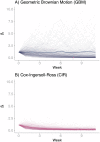Inferring the effective reproductive number from deterministic and semi-deterministic compartmental models using incidence and mobility data
- PMID: 35759506
- PMCID: PMC9269962
- DOI: 10.1371/journal.pcbi.1010206
Inferring the effective reproductive number from deterministic and semi-deterministic compartmental models using incidence and mobility data
Abstract
The effective reproduction number (ℜt) is a theoretical indicator of the course of an infectious disease that allows policymakers to evaluate whether current or previous control efforts have been successful or whether additional interventions are necessary. This metric, however, cannot be directly observed and must be inferred from available data. One approach to obtaining such estimates is fitting compartmental models to incidence data. We can envision these dynamic models as the ensemble of structures that describe the disease's natural history and individuals' behavioural patterns. In the context of the response to the COVID-19 pandemic, the assumption of a constant transmission rate is rendered unrealistic, and it is critical to identify a mathematical formulation that accounts for changes in contact patterns. In this work, we leverage existing approaches to propose three complementary formulations that yield similar estimates for ℜt based on data from Ireland's first COVID-19 wave. We describe these Data Generating Processes (DGP) in terms of State-Space models. Two (DGP1 and DGP2) correspond to stochastic process models whose transmission rate is modelled as Brownian motion processes (Geometric and Cox-Ingersoll-Ross). These DGPs share a measurement model that accounts for incidence and transmission rates, where mobility data is assumed as a proxy of the transmission rate. We perform inference on these structures using Iterated Filtering and the Particle Filter. The final DGP (DGP3) is built from a pool of deterministic models that describe the transmission rate as information delays. We calibrate this pool of models to incidence reports using Hamiltonian Monte Carlo. By following this complementary approach, we assess the tradeoffs associated with each formulation and reflect on the benefits/risks of incorporating proxy data into the inference process. We anticipate this work will help evaluate the implications of choosing a particular formulation for the dynamics and observation of the time-varying transmission rate.
Conflict of interest statement
I have read the journal’s policy and the authors of this manuscript have the following competing interests: 1. Prof. Jim Duggan is a member of the WHO Global Outbreak and Response Network (GOARN), through the involvement of the National University of Ireland Galway as a GOARN partner. (NGO) 2. Prof. Jim Duggan is a member of the Irish Epidemiological Modelling Advisory Group (IEMAG), and in this volunteering role, provides modelling advice to the Department of Health, Ireland. Also, the work presented is independent of (1) and has only benefited from an aggregated data set received from (2).
Figures







References
-
- Anderson RM, May RM. Infectious Diseases of Humans: Dynamics and Control. Oxford University Press; 1992.
-
- Nishiura H, Chowell G. In: Chowell G, Hyman JM, Bettencourt LMA, Castillo-Chavez C, editors. The Effective Reproduction Number as a Prelude to Statistical Estimation of Time-Dependent Epidemic Trends. Dordrecht: Springer Netherlands; 2009. p. 103–121. Available from: 10.1007/978-90-481-2313-1_5. - DOI
-
- Vynnycky E, White R. An Introduction to Infectious Disease Modelling. Oxford University Press; 2010.
Publication types
MeSH terms
LinkOut - more resources
Full Text Sources
Medical

